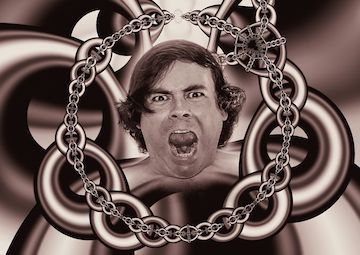The Four Noble Truths ~ The Second Noble Truth
The Noble Truth of the Origin of Suffering (dukkha-samudaya)
 )
)The origin of suffering can be viewed from a 3 life-time cycle of rebirth: the previous life, the present life, and the next life. This is how it shows the causal relationship between things done and the kamma / karma [cause and effect] acquired in a previous life to the present life, and things done and kamma / karma acquired in the present life that will affect the next life.
“And what is the origin of suffering?

It is craving, which brings renewal of being, is accompanied by delight and lust, and delights in this and that;
that is,

- craving for sensual pleasures,
- craving for being [repeated rebirth], and
- craving for non-being [extermination].
This is called the origin of suffering.” — MN I.48

The origin of suffering might be translated as the cause of suffering, or to indicate what causes the arising of suffering. This is to accentuate that the practice of Buddhism has more to do with the causes of suffering, and the practice should lead to the cessation or diminishing of the causes of suffering. Suffering does not arise in a vacuum, so the Buddhist teachings explain the formative chains or links that show how suffering arises:
“And what, monks, is the noble truth of the origin of suffering?

- With ignorance as condition, volitional activities arise;
- with volitional activities as condition, consciousness arises;
- with consciousness as condition, name-and-form ariwith name-and-form as condition, the six sense baseswith the six sense bases as contact arises;
- with contact as condition, feeling arises;
- with feeling as condition, craving arises;
- with craving as condition, clinging arises;
- with clinging as condition, existence arises;
- with existence as condition, birth arises;
- with birth as condition, old age and death, sorrow, lamentation, pain, dejection, and anguish arise.
Such is the origin of this whole mass of suffering.” — AN I.177

Besides the explanation of how suffering arises, it is beneficial to get an understanding of how and where craving gets established, as it forms a vital role in the previous chain of causes that lead to suffering. Craving is the grasping for intangible [mentality] and tangible objects, where the quality projected onto those objects by the grasping person is perceived as pleasurable and enjoyable. In this complexity of the arising and establishing, the five senses, it’s 5 sense objects that are being grasped, and the consciousness of those objects in the mind all play a part of how craving comes to be and is maintained through a cycle of perpetual motion for pleasurable and enjoyable experience in the mind. This craving and grasping projects a quality onto the objects that is invalid, as such that it is perceived as a permanent experience, whereas reality proves every single time that whatever arises will also cease eventually, leading to disappointment and hence suffering.
“But where does this craving, monks, arise and where does it get established?

Wherever in the world [of mind and matter] there is something enticing and pleasurable, there this craving arises and gets established.” — Mahasatipatthana Sutta
The teaching continuous to explain this in more detail. The pleasurable quality is explained in the form of sensation, perception, how the mind reacts to it, the continued craving, how the mind conceptualizes thoughts based on them, and how the mind keeps itself focussed on these fleeting moments of it all:
“But what in the world [of mind and matter] is enticing and pleasurable?

The eye, ear, nose, tongue, body, [and] mind in the world of mind and matter;
Visible objects, material forms, sounds, smells, tastes, touch, [and] contents of the mind in the world of mind and matter;
The eye-consciousness, ear-, nose-, tongue-, body-, [and] mind-consciousness in the world of mind and matter;
The eye-contact, ear-, nose-, tongue-, body-, and mind-contact in the world of mind and matter;
The sensation arising from the eye-contact, ear-contact, nose-contact, tongue-contact, body-contact, and mind-contact in the world of mind and matter;
The perception of visible objects, of material forms, sounds, smells, tastes, touch, and contents of the mind in the world of mind and matter;

The mental reaction to visible objects, to material forms, sounds, smells, tastes, touch, and mind objects and mental contents in the world of mind and matter;
The craving after visible objects, after material forms, sounds, smells, tastes, touch, and mind objects and mental contents in the world of mind and matter;

The thought conception of visible objects, of material forms, sounds, smells, tastes, touch, and mind objects and mental contents in the world of mind and matter;
The rolling in thoughts of visible objects, of material forms, sounds, smells, tastes, touch, and mind objects and mental contents in the world of mind and matter;

are [all] enticing and pleasurable;
there this craving arises and gets established.” — Mahasatipatthana Sutta

This might all seem a bit much to comprehend at first, but the Buddhist teachings are about the gradual increase of understanding and do not demand full understanding immediately. The Buddhist teachings are written for repeated reading and contemplation of what they mean. The explanation given also at first will seem a bit schematic, when compared to one’s experience in meditation, but hopefully it starts to match the meditative experience over time.
In the next part we’ll be discussing the Third Noble Truth.

I will flag comment spam at 1% strength. If you keep on spamming my post, I will flag you at 100%. I don't care if you have limited English abilities, write a couple of sentences about this article, no copy-paste, please. I will flag: one sentence comments, links to your blog and begging for up-votes and follows. Also, I will flag comments that have nothing to do with my blog's article. I will also check your comment section to see if you have been comment spamming on other blogs.


 A link to My Blog
A link to My Blog
I've always been interested in the Buddhist religion but knew very little about it. As I am following your series it seems that so much pain and misery that we suffer comes from within us. Maybe learning to " let go"can help our quality of life. I will be watching for the third noble truth. Thanks for this good information.
I know that how I reacted to horrible things that happened to me caused me pain but no matter how many therapy sessions I had or medication I took I couldn't let go of my PTSD caused from childhood abuse, the death of my father and an abusive marriage. I kept reacting and creating more messes in my life and troubles for my family.
When I read about Buddhism and what Buddha taught I knew this was exactly what I needed to let go of old conditioning. I know many other people who found the same path through other practices...soooo, all this is subject to one's karma ;-)
Suffering it's something common in humans lives but you can change the switch to avoid that feeling and get a best atmosphere for you and all around you it's just my opinion dear red, it's difficult because is a topic too much deep but i think we can act to avoid suffering for example when any girl live with a man tha hits her so you can change it but no always you can do it because there are many factors. Regards
All humans suffer from birth to death, illness, loss, we all experience this and this is something we cannot avoid. However, we can avoid reacting to these truths in a negative way which, mitigates suffering greatly. When someone hits you, you can leave without taking their hatred and anger with you...you let them own it, don't pick it up by becoming angry, resentful, full of revenge and sadness.....this is one of the first truths I learned from my teacher Sunim.
Correct the same i think, it's a topic very difficult. Regards
@reddust, Yesterday Poyaday to Sri Lankan Buddhists. So explained better second noble truth of part no four noble truth. Dukkha-samudaya is a Sinhala meaning there. Our religious leader Lord Buddha better explain these part of truth with shown examples around life time. I totally salute you coz you start a blogs to update every steemians. I see lot of foreigners known about Buddhism and reach with our religion. I met and talked with some foreigners, they told me really satisfying and felt relaxation with Buddhist progress. Nice you decided to share.
Thank you @madushanka, with the troubles in the world and the frustrations here on Steemit, I thought this series might be a healing balm for sore hearts. I wish I could go to the Dharma teachings with you...maybe someday!
Sure...If you have plan about it definitely give my contribution.
the noble truth that deeply touches the heart [email protected] am waiting for the next one.my upvote and resteem your post @ reddust
These noble truths helped me save my life and my families life, thank you @lusi
four excellent truths [email protected] very happy with the first and the second, I wait for the third and the fourth.postingan weighted
Thank you @pengenkaya, these truths are soothing to a troubled heart.
the origin of suffering is caused by the first we often speak lies or lies, often deceiving people, that is the cause of suffering, a good friend post.
The Buddha said:
This stress (dukkha) is caused by ignorance of grasping these five categories as lasting, unchanging. When we let go of changing the stress is gone and we can see reality as it is...this letting go is the Noble Eightfold Path...
Lying, cheating, all the stress comes from grasping at these five categories as me or mine.
https://www.accesstoinsight.org/tipitaka/sn/sn56/sn56.011.nymo.html
Hola @reddust, excelente post , tiene un lenguaje y coordinacion genial .
Me gusto mucho su post, espero los siguientes .
El sufrimiento , es deficil de ignorar , solo piensa , cuando nacemos , lo primero que hacemos es llorar.
Bendiciones :)
No podemos ignorar el sufrimiento, esto puede llevar a reacciones negativas. Si podemos ver claramente los orígenes del sufrimiento sin ecuanimidad, entonces podemos tratar el sufrimiento correctamente. Gracias...@martha75
Truth is good to share thank you for sharing a little bit of why you believe people suffer and it helps to mold them into the person they become blessings to you this Easter @reddust
Happy Easter @enjoywithtroy, I remember reading sin is missing the mark. The mark being God and through
the imitation of Christ we can know God ...
Removing habitual reactions, the eye is clear and the mark won't be missed!
I love Thomas Kempis and his book The Imitation of Christ.
It only gets better when we truly know the root cause of a problem and try to hewn it down so that we would be free.
I read the first noble truth on suffering and I must say I was enlightened.just Like I commented initially on that one, no one is born exonerated from suffering in one way or the other, we choose to suffer when we unknowingly cling onto mundane things of this world.
This teachings are really evident in our lives and very practicable.
I guess I have learnt another reason for suffering.
Thanks for the update, expectantly waiting for the third noble truth
I will be responding to comments on my other posts, I've been painting and I just got out of the artistic part of my head. The transition from creating pictures to creating words is difficult for me...hahaha
We can't avoid life but we can avoid negative reations to what life gives us and this removes most of our sufferings. Thank you @cyprianj!
This is quite a deep truth, the mind creates the craving based on sensual perception - once you enjoyed something you will have to give it up eventually or to suffer pain. Pretty hard, thank you for making me realize this powerful truth